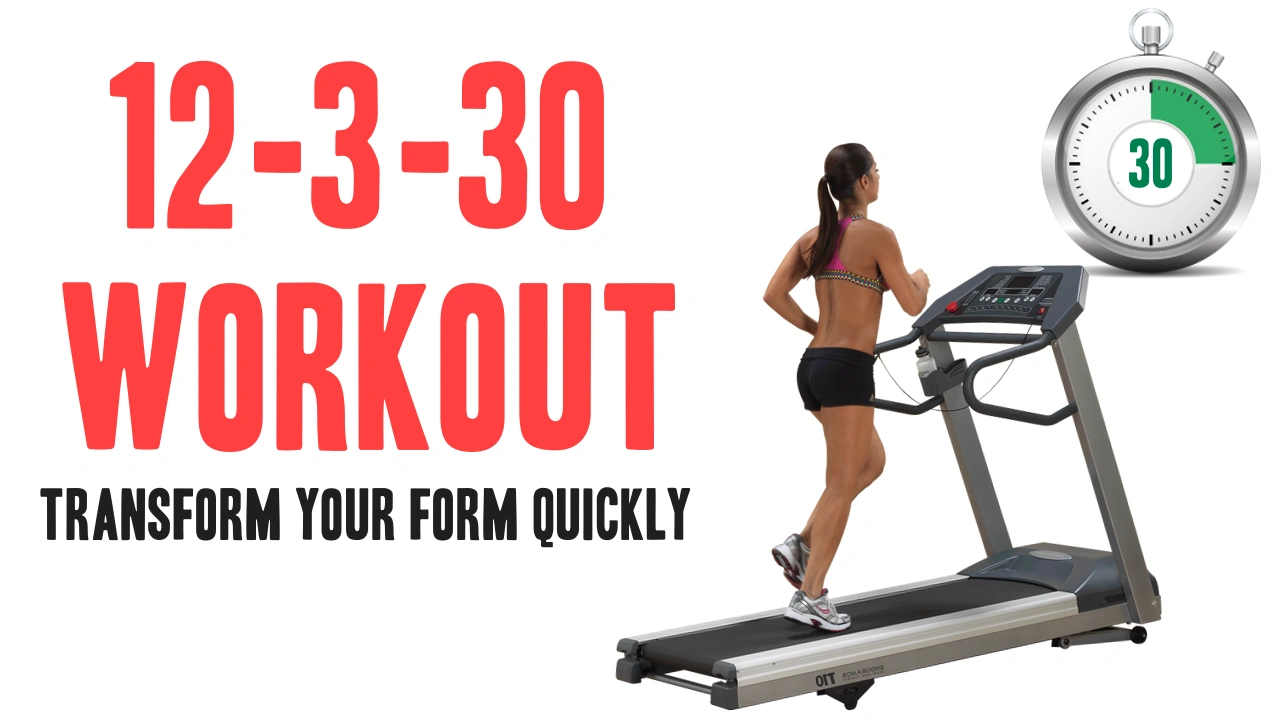Contents
The 12-3-30 workout is a treadmill-based walking routine that gained widespread popularity through social media, particularly for its simplicity and effectiveness in promoting fat loss, cardiovascular health, and lower-body endurance.
The format is easy to follow:
- Incline: 12%
- Speed: 3 miles per hour
- Duration: 30 minutes
Though it appears straightforward, this protocol places a continuous, low-impact demand on the cardiovascular and muscular systems, making it a versatile tool for beginners, fat-loss clients, and those seeking sustainable daily activity.
What Is the 12-3-30 Workout?
The 12-3-30 workout is a treadmill routine that involves walking at a 12% incline, at a speed of 3.0 mph, for 30 minutes straight. It was popularized by influencer Lauren Giraldo and has since become a trending method for people looking to improve body composition, especially without high-intensity or high-impact movement.

What Does the 12-3-30 Workout Do?
1. Promotes Fat Loss and Energy Expenditure
Walking on a steep incline significantly increases your calorie burn compared to flat-ground walking. While still considered a form of LISS (Low-Intensity Steady State) cardio, the incline makes your muscles work harder, boosting fat oxidation and metabolic rate during and after the workout.
A 2022 study published in Frontiers in Physiology confirmed that inclined walking burns more calories and fat than level walking at the same pace due to higher muscle activation and energy demands.
2. Builds Lower-Body Muscular Endurance
The incline engages the:
- Glutes
- Hamstrings
- Calves
- Quads
Over time, consistent incline walking enhances muscular stamina and contributes to tone and definition in the posterior chain without the joint stress associated with high-impact activities like running or jumping.
3. Improves Cardiovascular Health
The sustained 30-minute duration, paired with the incline’s demand, elevates your heart rate into the moderate-intensity aerobic zone, improving:
- Heart and lung capacity
- Blood pressure regulation
- Circulatory efficiency
4. Enhances Daily Activity and Consistency
One of the most overlooked benefits of 12-3-30 is adherence. Its simplicity and relatively low barrier to entry make it an excellent option for:
- Beginners
- Individuals returning to exercise
- Those with joint concerns
- Clients who need a structured daily movement habit
Benefits of the 12-3-30 Workout
| Benefit | Explanation |
|---|---|
| Low Impact | Gentle on the joints, making it ideal for older adults or injury recovery |
| High Adherence | Easy to remember and stick with; sustainable for daily or weekly routines |
| Accessible | Requires only a treadmill; no equipment or technical skill needed |
| Effective for Fat Loss | Elevates energy expenditure in a manageable, consistent way |
| Glute and Hamstring Activation | Greater posterior chain involvement due to incline walking mechanics |
Is the 12-3-30 Workout Good for Everyone?
While effective and approachable, it may not be suitable for:
- People with back or knee pain: Steep incline walking can place stress on lumbar spine and knees.
- Individuals with cardiovascular limitations: Always consult a healthcare provider before starting incline-based cardio.
- Advanced athletes: May find it too light unless paired with strength training or conditioning circuits.
How Often Should You Do the 12-3-30 Workout?
Beginners:
2–3 times per week as part of a general fitness routine
Fat Loss Clients:
3–5 sessions weekly, paired with strength training and nutrition tracking
For Maintenance or Habit Building:
Daily or alternate-day use as a form of active recovery or general movement
Tips for Best Results
- Warm up for 3–5 minutes at a flat incline before starting
- Use proper posture: Keep your core engaged, avoid leaning on handrails
- Pair with strength training: To maintain muscle mass and enhance body composition
- Track intensity: Heart rate monitors or perceived exertion scales can help
- Stay hydrated, especially in heated indoor gym environments
Sample Weekly Schedule (Fat Loss Focus)
| Day | Workout |
|---|---|
| Monday | 12-3-30 + Upper Body Strength |
| Tuesday | Rest or Mobility Work |
| Wednesday | 12-3-30 + Core Training |
| Thursday | Lower Body Strength |
| Friday | 12-3-30 Only |
| Saturday | Active Recovery (walk, stretch) |
| Sunday | Rest |
Conclusion
The 12-3-30 workout offers a low-impact, high-output, and accessible method for improving cardiovascular fitness, supporting fat loss, and developing muscular endurance—particularly in the glutes and hamstrings. Its simplicity, paired with metabolic efficiency, makes it a compelling option for those looking to build a long-term habit of movement.
Whether you’re a beginner, looking to re-engage with cardio, or seeking a consistent addition to your routine, the 12-3-30 plan offers a practical and effective way to move more and improve your health.
References
- Uthoff, H.N., et al. (2022). Inclined vs. Level Walking: Energy Expenditure and Cardiovascular Responses. Frontiers in Physiology.
- Kravitz, L. (2016). The Science of Walking. American Council on Exercise. https://www.acefitness.org/education-and-resources/professional/expert-articles/6180/the-science-of-walking/
- ACSM. (2021). ACSM’s Guidelines for Exercise Testing and Prescription, 11th Edition.



